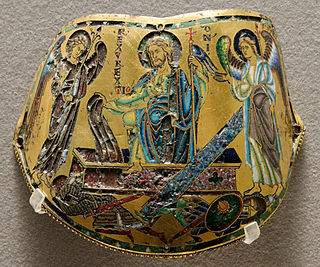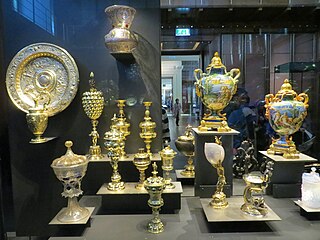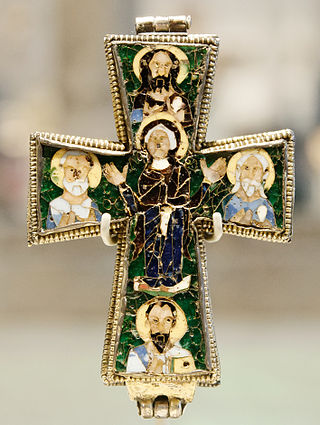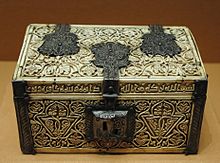
Relief is a sculptural method in which the sculpted pieces remain attached to a solid background of the same material. The term relief is from the Latin verb relevare, to raise. To create a sculpture in relief is to give the impression that the sculpted material has been raised above the background plane. When a relief is carved into a flat surface of stone or wood, the field is actually lowered, leaving the unsculpted areas seeming higher. The approach requires a lot of chiselling away of the background, which takes a long time. On the other hand, a relief saves forming the rear of a subject, and is less fragile and more securely fixed than a sculpture in the round, especially one of a standing figure where the ankles are a potential weak point, particularly in stone. In other materials such as metal, clay, plaster stucco, ceramics or papier-mâché the form can be simply added to or raised up from the background. Monumental bronze reliefs are made by casting.

A reliquary is a container for relics. A portable reliquary may be called a fereter, and a chapel in which it is housed a feretory or feretery.

The Bimaran casket or Bimaran reliquary is a small gold reliquary for Buddhist relics that was removed from inside the stupa no.2 at Bimaran, near Jalalabad in eastern Afghanistan.

Champlevé is an enamelling technique in the decorative arts, or an object made by that process, in which troughs or cells are carved, etched, die struck, or cast into the surface of a metal object, and filled with vitreous enamel. The piece is then fired until the enamel fuses, and when cooled the surface of the object is polished. The uncarved portions of the original surface remain visible as a frame for the enamel designs; typically they are gilded in medieval work. The name comes from the French for "raised field", "field" meaning background, though the technique in practice lowers the area to be enamelled rather than raising the rest of the surface.

A treasure binding or jewelled bookbinding is a luxurious book cover using metalwork in gold or silver, jewels, or ivory, perhaps in addition to more usual bookbinding material for book covers such as leather, velvet, or other cloth. The actual bookbinding technique is the same as for other medieval books, with the folios, normally of vellum, stitched together and bound to wooden cover boards. The metal furnishings of the treasure binding are then fixed, normally by tacks, onto these boards. Treasure bindings appear to have existed from at least Late Antiquity, though there are no surviving examples from so early, and Early Medieval examples are very rare. They were less used by the end of the Middle Ages, but a few continued to be produced in the West even up to the present day, and many more in areas where Eastern Orthodoxy predominated. The bindings were mainly used on grand illuminated manuscripts, especially gospel books designed for the altar and use in church services, rather than study in the library.

Ivory carving is the carving of ivory, that is to say animal tooth or tusk, generally by using sharp cutting tools, either mechanically or manually. Objects carved in ivory are often called "ivories".

Bone carving is creating art, tools, and other goods by carving animal bones, antlers, and horns. It can result in the ornamentation of a bone by engraving, painting or another technique, or the creation of a distinct formed object. Bone carving has been practiced by a variety of world cultures, sometimes as a cheaper, and recently a legal, substitute for ivory carving. As a material it is inferior to ivory in terms of hardness, and so the fine detail that is possible, and lacks the "lustrous" surface of ivory. The interior of bones are softer and even less capable of a fine finish, so most uses are as thin plaques, rather than sculpture in the round. But it must always have been much easier to obtain in regions without populations of elephants, walrus or other sources of ivory.

The term Poor Man's Bible has come into use in modern times to describe works of art within churches and cathedrals which either individually or collectively have been created to illustrate the teachings of the Bible for a largely illiterate population. These artworks may take the form of carvings, paintings, mosaics or stained-glass windows. In some churches a single artwork, such as a stained-glass window, has the role of Poor Man's Bible, while in others, the entire church is decorated with a complex biblical narrative that unites in a single scheme.

A decorative box is a form of packaging that is generally more than just functional, but also intended to be decorative and artistic. Many such boxes are used for promotional packaging, both commercially and privately. Historical objects are usually called caskets if larger than a few inches in more than one dimension, with only smaller ones called boxes.

Limoges enamel has been produced at Limoges, in south-western France, over several centuries up to the present. There are two periods when it was of European importance. From the 12th century to 1370 there was a large industry producing metal objects decorated in enamel using the champlevé technique, of which most of the survivals, and probably most of the original production, are religious objects such as reliquaries.

A chasse, châsse or box reliquary is a shape commonly used in medieval metalwork for reliquaries and other containers. To the modern eye the form resembles a house, though a tomb or church was more the intention, with an oblong base, straight sides and two sloping top faces meeting at a central ridge, often marked by a raised strip and decoration. From the sides there are therefore triangular "gable" areas.

In 1898 Baron Ferdinand de Rothschild bequeathed to the British Museum as the Waddesdon Bequest the contents from his New Smoking Room at Waddesdon Manor. This consisted of a wide-ranging collection of almost 300 objets d'art et de vertu, which included exquisite examples of jewellery, plate, enamel, carvings, glass and maiolica. One of the earlier objects is the outstanding Holy Thorn Reliquary, probably created in the 1390s in Paris for John, Duke of Berry. The collection is in the tradition of a schatzkammer, or treasure house, such as those formed by the Renaissance princes of Europe; indeed, the majority of the objects are from late Renaissance Europe, although there are several important medieval pieces, and outliers from classical antiquity and medieval Syria.

Pastiglia, an Italian term meaning "pastework", is low relief decoration, normally modelled in gesso or white lead, applied to build up a surface that may then be gilded or painted, or left plain. The technique was used in a variety of ways in Italy during the Renaissance. The term is mostly found in English applied to gilded work on picture frames or small pieces of furniture such as wooden caskets and cassoni, and also on areas of panel paintings, but there is some divergence as to the meaning of the term between these specialisms.

In the early Middle Ages, there were distinct material cultures evident in the different federations and kingdoms within what is now Scotland. Pictish art was the only uniquely Scottish medieval style; it can be seen in the extensive survival of carved stones, particularly in the north and east of the country, which hold a variety of recurring images and patterns. It can also be seen in elaborate metal work that largely survives in buried hoards. Irish-Scots art from the kingdom of Dál Riata suggests that it was one of the places, as a crossroads between cultures, where the Insular style developed.

The Brescia Casket, also called the lipsanotheca of Brescia or reliquary of Brescia, is an ivory box, perhaps a reliquary, from the late 4th century, which is now in the Museo di Santa Giulia at San Salvatore in Brescia, Italy. It is a virtually unique survival of a complete Early Christian ivory box in generally good condition. The 36 subjects depicted on the box represent a wide range of the images found in the evolving Christian art of the period, and their identification has generated a great deal of art-historical discussion, though the high quality of the carving has never been in question. According to one scholar: "despite an abundance of resourceful and often astute exegesis, its date, use, provenance, and meaning remain among the most formidable and enduring enigmas in the study of early Christian art."

The Pyxis of Zamora is an carved ivory casket (pyx) that dates from the Caliphate of Córdoba. It is now in the National Archaeological Museum of Spain in Madrid, Spain.

The craft of cloisonné enameling is a metal and glass-working tradition practiced in the Byzantine Empire from the 6th to the 12th century AD. The Byzantines perfected an intricate form of vitreous enameling, allowing the illustration of small, detailed, iconographic portraits.

The Trier Cathedral Treasury is a museum of Christian art and medieval art in Trier, Germany. The museum is owned by the Roman Catholic Diocese of Trier and is located inside the Cathedral of Trier. It contains some of the church's most valuable relics, reliquaries, liturgical vessels, ivories, manuscripts and other artistic objects. The history of the Trier church treasure goes back at least 800 years. In spite of heavy losses during the period of the Coalition Wars, it is one of the richest cathedral treasuries in Germany. With the cathedral it forms part of a UNESCO World Heritage Site.

House-shaped shrine are early medieval portable metal reliquary formed in the shape of the roof of a rectangular building. They originate from both Ireland and Scotland and mostly date from the 8th or 9th centuries. Typical example consist of a wooden core covered with silver and copper alloy plates, and were built to hold relics of saints or martyrs from the early Church era; a number held corporeal remains when found in the modern period, presumably they were parts of the saint's body. Others, including the Breac Maodhóg, held manuscripts associated with the commemorated saint. Like many Insular shrines, they were heavily reworked and embellished in the centuries following their initial construction, often with metal adornments or figures influenced by Romanesque sculpture.

The Embriachi workshop was an important producer of objects in carved ivory and carved bone, set in a framework of inlaid wood, in north Italy from around 1375 to perhaps as late as 1433, apparently moving from Florence to Venice about 1395. They are especially known for what are now called marriage caskets or wedding caskets, hexagonal or oblong caskets about a foot across, with lids that rise up in the centre. Their output of these was probably made for stock rather than individual commissions, and filled a market for gifts for betrothals and weddings. They sold mirrors framed in a similar style, though fewer of these have survived, and religious pieces both small and in a few cases very large.
























